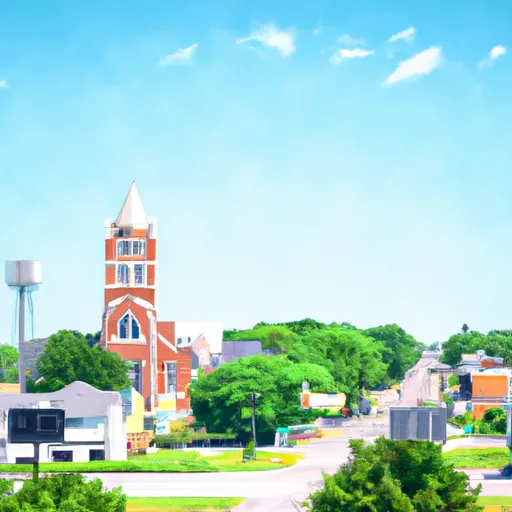-
 Snoflo Premium
Snoflo Premium
Get unlimited access to all our content
With no Ad interruptions! - Start Your Free Trial Login with existing account
Van-Wert
Eden Index
Climate
7.8
•
Recreation
2.8
•
Community
•
Safeguard
4.1/10

Van Wert, Iowa is a small town located in the southwestern part of the state. The climate in Van Wert is characterized by hot summers and cold winters. Summers are typically warm, with average temperatures ranging from the mid-80s to low 90s Fahrenheit. Winters, on the other hand, are cold and snowy, with average temperatures hovering around the low 20s to mid-30s Fahrenheit.
In terms of hydrology constituents, Van Wert benefits from the presence of the Grand River, which flows through the town. This river provides opportunities for fishing enthusiasts, with popular catches including catfish, bass, and panfish. Additionally, the river offers a scenic backdrop for activities such as kayaking and canoeing.
Outdoor recreation opportunities in Van Wert are abundant. The town is surrounded by picturesque landscapes, making it an ideal destination for hiking and biking. The nearby forests and parks offer trails for nature lovers to explore, providing opportunities to observe wildlife and enjoy the beauty of the area. Van Wert also boasts well-maintained campgrounds, perfect for those seeking a serene camping experience amidst nature.
What is the Eden Index?
The Snoflo Eden Index serves as a comprehensive rating system for regions, evaluating their desirability through a holistic assessment of climate health, outdoor recreation opportunities, and natural disaster risk, acknowledging the profound impact of these factors on livability and well-being.
Climate Health Indicator (CHI): 7.8
Van-Wert receives approximately
933mm of rain per year,
with humidity levels near 80%
and air temperatures averaging around
10°C.
Van-Wert has a plant hardyness factor of
5, meaning
plants and agriculture in this region thrive during a short period during spring and early summer. Most
plants will die off during the colder winter months.
By considering the ideal temperature range, reliable water supplies, clean air, and stable seasonal rain or snowpacks, the Climate Health Indicator (CHI) underscores the significance of a healthy climate as the foundation for quality living.
A healthy climate is paramount for ensuring a high quality of life and livability in a region, fostering both physical well-being and environmental harmony. This can be characterized by ideal temperatures, reliable access to water supplies, clean air, and consistent seasonal rain or snowpacks.
Weather Forecast
Streamflow Conditions
Grand
Area Rivers
Grand
Snowpack Depths
Grand
Reservoir Storage Capacity
Grand
Groundwater Levels
Recreational Opportunity Index (ROI): 2.8
The Recreational Opportunity Index (ROI) recognizes the value of outdoor recreational options, such as parks, hiking trails, camping sites, and fishing spots, while acknowledging that climate plays a pivotal role in ensuring the comfort and consistency of these experiences.
Access to outdoor recreational opportunities, encompassing activities such as parks, hiking, camping, and fishing, is crucial for overall well-being, and the climate plays a pivotal role in enabling and enhancing these experiences, ensuring that individuals can engage in nature-based activities comfortably and consistently.
Camping Areas
| Campground | Campsites | Reservations | Toilets | Showers | Elevation |
|---|---|---|---|---|---|
| Sparrowfoot - Harry S. Truman Lake | None | 731 ft | |||
| Osceola RV Park | 48 | 732 ft | |||
| Crabtree Cove - Stockton Lake | None | 902 ft | |||
| Daly County Park | 86 | 1,037 ft | |||
| Stockton State Park | None | 910 ft | |||
| Orleans Trail North Park -Stockton Lake | None | 931 ft | |||
| Hawker Point - Stockton Lake | None | 977 ft | |||
| Talley Bend - Harry S. Truman Lake | None | 822 ft | |||
| Bucksaw - Harry S. Truman Lake | None | 738 ft | |||
| Orleans Trail South Park - Stockton Lake | None | 936 ft |
Nearby Ski Areas
Catastrophe Safeguard Index (CSI):
The Catastrophe Safeguard Index (CSI) recognizes that natural disaster risk, encompassing floods, fires, hurricanes, and tornadoes, can drastically affect safety and the overall appeal of an area.
The level of natural disaster risk in a region significantly affects safety and the overall livability, with climate change amplifying these risks by potentially increasing the frequency and intensity of events like floods, fires, hurricanes, and tornadoes, thereby posing substantial challenges to community resilience and well-being.
Community Resilience Indicator (CRI):
The Community Resilience Indicator (CRI) recognizes that education, healthcare, and socioeconomics are crucial to the well-being of a region. The CRI acknowledges the profound impact of these elements on residents' overall quality of life. By evaluating educational resources, healthcare accessibility, and economic inclusivity, the index captures the essential aspects that contribute to a thriving community, fostering resident satisfaction, equity, and social cohesion.

